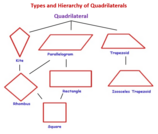
Classifying Quadrilaterals Mathematics Instructional Plan
- Subject:
- Mathematics
- Material Type:
- Lesson Plan
- Provider:
- VDOE
- Author:
- VDOE
- Date Added:
- 10/07/2024

Classifying Quadrilaterals Mathematics Instructional Plan

Exploring Quadrilaterals Task Template, Student Version of Task, Anchor Pages and Scoring Rationale

Solve Practical Problems involving Relationship between Corresponding Sides and Corresponding Angles of Similar Quadrilaterals and Triangles Formative Assessment - Just in Time Quick Check, Teacher Notes, and Supporting Resources

Solve a proportion to determine the missing side length of similar quadrilaterals or triangles - Mathematics Instructional Plan

Determining whether two plane figures are similar, identifying corresponding sides - Mathematics Instructional Plan

Compare and contrast the properties of quadrilaterals - Mathematics Instructional Plan

Compare and Contrast Quadrilaterals Formative Assessment - Just in Time Quick Check, Teacher Notes, and Supporting Resources

Deepen understanding of quadrilaterals - Rich Mathematical Task Template and Student Version

Determine Unknown Side Lengths or Angle Measures of Quadrilaterals Formative Assessment - Just in Time Quick Check, Teacher Notes, and Supporting Resources

Determine unknown side lengths or angle measures of quadrilaterals - Mathematics Instructional Plan

Compare and contrast the properties of quadrilateralsMathematics Instructional Plans (MIPs) help teachers align instruction with the 2016 Mathematics Standards of Learning (SOL) by providing examples of how the knowledge, skills and processes found in the SOL and curriculum framework can be presented to students in the classroom.

The students will visualize how the properties of Quadrilaterals can help them determine the exact shape of the figure. The students will create a model of the properties and compare them to the results the students have from data they have found

Classifying a variety of quadrilaterals based on properties. Mathematics Instructional Plans (MIPs) help teachers align instruction with the 2016 Mathematics Standards of Learning (SOL) by providing examples of how the knowledge, skills and processes found in the SOL and curriculum framework can be presented to students in the classroom.

Properties of Quadrilaterals Mathematics Instructional Plan

This resource is a series of Google Slides that asks if two attributes of quadrilaterals and triangles can exist together 'Never, Sometimes, or Always.' After posing the question, the following slide will show the an and possible examples of the given polygons.

Just in Time Quick Check Quadrilaterals

In this first part of a three part series, students will explore the ideas around Brute Force algorithm/programs to further understand the importance of password development, use, safety, and safekeeping while completing several unplugged activities over the course of three class periods (approximately 30-45 minutes each). These activites can be completed seperately with a few adjustments as well. Part 1 introduces Brute Force using a playing cards demonstration to sort as desired. Part 2 introduces Decrease (or Divide) and Conquer to sort Quadrilaterals from Non-Quadrilateral shapes. Part 3 uses the methods of both Brute Force and Divide and Conquer algorithms to decrypt (unscramble) passwords using commonly recognizable number patterns and words (completed on paper, or unplugged). These activitess are intended for upper middle school students, but could also be adjusted for lower level highschool or simplified/adjusted for other ages as well with the editable copies provided.

In this second part of a three part series, students will explore the ideas around Decrease, or Divide, and Conquer algorithm/programs to further understand the importance of password development, use, safety, and safekeeping by completing several unplugged activities over the course of three class periods (approximately 30-45 minutes each). These activites can be completed seperately (stand-alone) with a few adjustments as well. Part 1 introduces Brute Force using a playing cards demonstration to sort as desired. Part 2 introduces Decrease (or Divide) and Conquer to sort Quadrilaterals from Non-Quadrilateral shapes. Part 3 uses the methods of both Brute Force and Divide and Conquer algorithms to decrypt (unscramble) passwords using commonly recognizable number patterns and words (completed on paper, or unplugged). These activitess are intended for upper middle school students, but could also be adjusted for lower level highschool or simplified/adjusted for other ages as well with the editable copies provided.

This geometry lesson is a remix from Illustrative Mathematics. In this lesson, students identify triangles, quadrilaterals, pentagons and hexagons. Students are also required to make these shapes using manipulatives. https://tasks.illustrativemathematics.org/content-standards/tasks/1506

4.12 Quadrilateral Properties Co-Teaching MIP